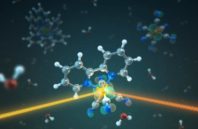Microscopes make the invisible visible. And compared to conventional light microscopes, transmission x-ray microscopes (TXM) can see into samples with much higher resolution, revealing extraordinary details. Researchers across a wide range of scientific fields use TXM to see the structural and chemical makeup of their samples — everything from biological cells to energy storage materials.
Scientists at the National Synchrotron Light Source II (NSLS-II) — a U.S. Department of Energy (DOE) Office of Science User Facility at DOE’s Brookhaven National Laboratory — have developed a TXM that can image samples 10 times faster than previously possible. Their research is published in Applied Physics Letters.
“We have significantly improved the speed of x-ray microscopy experiments,” said Wah-Keat Lee, lead scientist at NSLS-II’s Full Field X-ray Imaging (FXI) beamline, where the microscope was built. At FXI, Lee and his colleagues reduced the time it takes a TXM to image samples in 3-D from over 10 minutes to just one minute, while still producing images with exceptional 3-D resolution — below 50 nanometers, or 50 billionths of a meter. “This breakthrough will enable scientists to visualize their samples much faster at FXI than at similar instruments around the world,” Lee said.

 (585) 768-2513
(585) 768-2513

